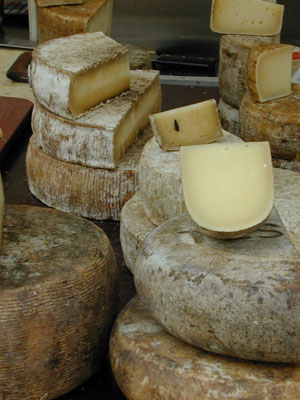 |
| Cheese Photo by Alex Anlicker |
In order to make any cheese you need the proper starters. These are natural milk bacteria that eat the lactose in the milk and produce
lactic acid that curdles the cheese and
gives each one its distinctive flavor.
Otto Bismarck the 19th century chancellor of Germany
one remarked that there were two processes that people should not watch, the
making of sausage, and the passing of laws.
He might just as well have included cheese making in his diatribe. To make cheese you have to have bacteria and
mold too they give the cheese its character and flavor.
A cheese culture is made of milk, butter milk actually that
has been inoculated with the proper bacteria from a specific cheese that will
impart its flavor to the cheese you want to make. This imparts lactic acid that will curdle the
milk you are going to make into cheese.
There are good germs, and bad germs any human body contains
several trillion different germs that supply many of our necessary life
functions. So it is with the bacteria
and mold that forms cheese. No matter
what cheese you want to produce you must start with a cheese starter.
Cheese making has been around for a long while as an ancient
practice with many different kinds of cheese recognized and handed down from
the past. Before the days of modern
science duplicating cheeses was hit or miss at best. Today some of the uncertainties have been
taken out of cheesemaking, but not all there are still surprises. Most batches of cheese work well however,
every once in a while a batch can go bad.
One of the biggest problems facing the old time cheesemakers
was their little choice of the proper starter cultures. When they made a good batch of cheese they
kept some of the whey overnight to use in the next day’s production. Usually this worked as the bacteria in the
whey multiplied and was ready to go to work the following day. However if some “Wild Bacteria” got into the
whey it could more then likely change whatever was produced the following day
with disastrous results. Making cheese
in the old times was by chance more then by art.
In modern practice however steps have been taken to remove
the factor of chance from the process as much as possible, but cheesemaking is
still an art even though much of the chance has been removed. One of the processes that has removed some of
this chance is the pasteurizing the milk to kill the bacteria found there. In effect this leaves you with a blank slate
to work with. This blank slate is open
to any bacteria that comes along whether it is good or bad.
The other process is the availability of commercially
available “cheesemaking cultures” that are added to the pasteurized milk to
start the cheesemaking process. This is
done by adding the starter culture, the rennet if the recipe calls for its use,
and the mold to ripen the cheese.
Unpastuerized milk actually holds the necessary bacteria to
make cheese, but if the lactic acid these bacteria exceeds the amount needed to
make a specific cheese the results will be a crumbly cheese. If there isn’t enough lactic acid it will
produce a cheese that has a pasty texture.
Proper quantities of lactic acid in your cheese will also help to drive
the whey from the curds. This is a
crucial step in the cheesemaking process except cheeses that are soft or
unripened like cottage cheese. The
formation of lactic acid aside from helping in the curdling of the milk also
helps in keeping dangerous bacteria out of the cheese.
Basically there are two different types of cultures
available for use, they are:
Mesophilic startersthat work at moderate temperatures whenever the curds will be warmed to a
temperature no greater then 102 degrees Fahrenheit. These cheeses include some of our favorite
cheeses like Cheddar and Gouda .
The other type of starter is Thermophilic that are heat loving cultures where the curds are
heated to a temperature not to exceed 132 degrees Fahrenheit for making various
Swiss and Italian cheeses.
Each basic type of starter has several subspecies one of
them is designed to be used with goat milk cheese only. This is one of the mesophilic starters. If you are making cheese at home you can
culture this using a small piece of your favorite cheese placed into buttermilk
as a culture. This is kept in a
refrigerator when not being used. You
should inoculate another batch of butter milk that has been pasteurized every
week. In this way you can keep a cheese
culture alive for generations much like a sour bread starter.
The thermophilic starter is cultured the same way except
this time it is cultured in unflavored yogurt.
The life of this starter can be extended for generations by inoculating
a fresh batch of yogurt once a week.
If in doubt you can purchase cheese starters from several
sources by Googling “Cheese Starters.”
References:
Cheese Making, http://schmidling.com/making.htm
Fankhauser’s Cheese Page, http://biology.clc.uc.edu/Fankhauser/Cheese/cheese.html

No comments:
Post a Comment